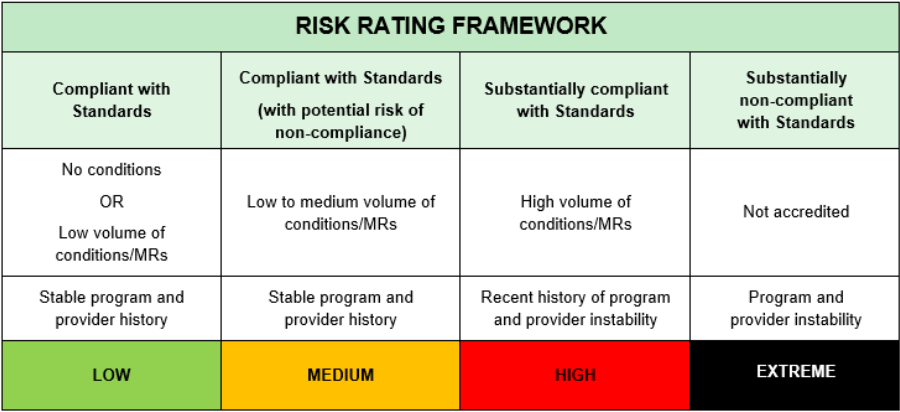

Version 2.2
Download the Accreditation Committee Decision Making Framework (7 pages PDF)
This document describes the framework we use to make accreditation decisions for pharmacy degree and intern training programs.
The Accreditation Committee uses a risk-based decision making framework for all its accreditation decisions.
To facilitate this decision making process the committee considers:
These elements form the framework.
The committee decides and monitors the accreditation of:
The Accreditation Committee (AC) is a standing committee of the APC. Its activities are governed through an APC Board approved By-Law. As per the By-Law, the AC’s primary purpose is to:
Decide and monitor the accreditation of Australian pharmacy degree programs, Intern Training Programs (ITPs) and CPD accrediting organisations against the relevant Accreditation Standards.
This Framework applies for AC decision-making in relation to degree and intern training programs under the agreement with Ahpra and the Pharmacy Board of Australia (PharmBA).
APC staff use a variety of tools and activities to undertake their quality assurance and to support the AC to make decisions regarding the accreditation of pharmacy programs.
These tools are outlined in the Accreditation Quality Assurance and Monitoring Policy.
Through these tools and activities, APC staff collate and review evidence and provide this to the AC to ensure program compliance against the relevant Accreditation Standards.
Following a quality assurance or monitoring activity, APC staff will produce a report and/or draft Accreditation Outcome Notification (AON) for the AC to review and make an accreditation decision.
In order to facilitate this decision-making process, and ensure consistency of decision making processes, the AC considers:
These three elements combine to form the decision making framework.

APC defines risk as ‘any potential or actual event, decision, action or inaction that could affect program compliance with the Standards’.
A number of factors are considered by the AC when determining program risk, including:
Programs will move between risk ratings depending on evidence provided and gathered through quality assurance and monitoring processes.

APC and the AC take into account risks to both the program and provider.
As the number/severity of non-compliances increases, and/or the program stability reduces, the risk rating will increase. The risk rating is used to determine the appropriate duration of accreditation for each program.
The AC will apply the guidelines below for programs that are eligible for a maximum accreditation period of 6 years and international degree programs:
The AC relies on evidence gathered through its quality assurance and monitoring activities to establish evidence for compliance.
The AC must determine both point in time and ongoing compliance for each program. If a provider has only recently met point in time compliance, it is likely that monitoring requirements (MRs) will be placed on the provider to ensure that compliance is ongoing.
Where evidence indicates that a criterion is substantially (but not entirely) met, the AC will apply a condition on the program. For degree programs this is also a requirement of Section 48(1)(b) of the National Law.
When compliance is assured against a condition, the AC either:
When a criterion is met but the AC requires further reassurance that the criterion will continue to be met for the duration of the accreditation period, the AC will apply a monitoring requirement (MR) on the program. For degree programs this is also a requirement of Section 50(1) of the National Law.
When reporting is submitted against a MR, the AC either:
The AC considers ‘reasonableness’ as an approach on decision making that ensures ‘fairness’ (e.g. would a ‘reasonable’ individual, given the same information, reach the same conclusion).
The AC applies reasonableness through:
Australian Health Practitioners Regulation Agency, Health Practitioners Regulation National Law Act
Australian Pharmacy Council, Accreditation Committee By-Law
Australian Pharmacy Council, Accreditation Quality Assurance and Monitoring Policy